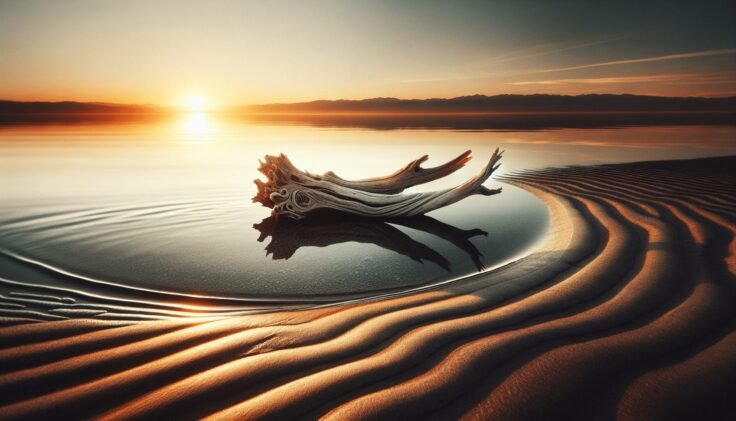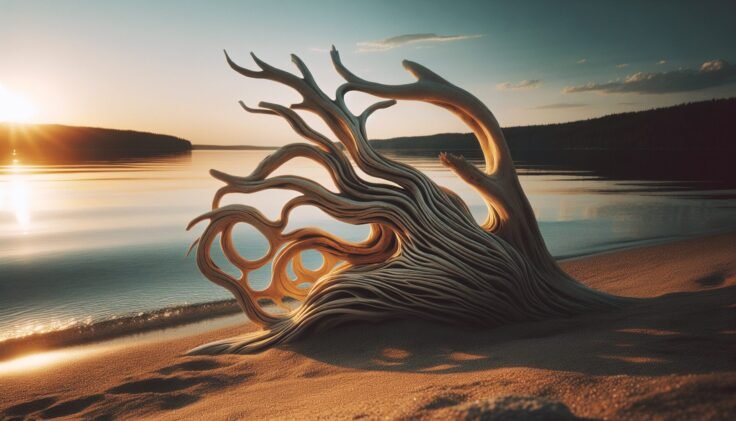Have you ever walked along a beach and stumbled upon pieces of driftwood with unique shapes and textures? These natural pieces, weathered by the sea, hold the potential to be transformed into beautiful art. One of the most creative and patriotic uses for driftwood is crafting an American flag. Imagine incorporating nature into your home decor with a piece that not only has character but also tells a story of the ocean’s journey.
What is a Driftwood American Flag?
A driftwood American flag is a decorative representation of the U.S. flag using pieces of driftwood as the canvas. This unique crafting process involves arranging and painting driftwood in a way that mimics the red, white, and blue stripes and stars of the traditional American flag. Incorporating natural elements into an iconic symbol not only celebrates patriotism but also honors the beauty of nature.
The Appeal of Driftwood
Driftwood’s charm lies in its natural and rugged appearance, with each piece offering its own history and story. Driftwood is formed when pieces of wood are washed ashore by the sea, sanded smooth by the constant motion of the waves and elements. This means that no two pieces are ever the same, making your driftwood American flag a truly unique piece of art.
Historical Context
Creating art from driftwood is not a new concept. Artists have long been inspired by the sea and its gifts, using driftwood in various forms of art for centuries. However, the use of driftwood to craft an American flag adds a layer of meaning that combines tradition with innovation.
The Symbolism of the American Flag
The American flag, with its stars and stripes, represents the history, values, and vision of the United States. It is a symbol of freedom and democracy, deeply woven into the fabric of American identity. By recreating this emblem with driftwood, you merge these powerful symbols with the ethos of natural beauty and sustainability.

Gathering Materials
Before you begin your project, it’s essential to gather all the necessary materials. This ensures that your crafting process is smooth and enjoyable.
Collecting Driftwood
The first step is collecting driftwood. You can find driftwood pieces on many beaches; they are typically light gray or brown and come in various shapes and sizes. Safety first—ensure that collecting driftwood is permitted in the area you’re visiting. Look for straight pieces for stripes and more irregular ones for creating stars.
Additional Supplies
For your driftwood flag, you will need:
- Acrylic paints (red, white, and blue)
- Paintbrushes
- Sandpaper
- Wood glue or nails
- A saw for trimming wood pieces
- Optional: Stencils for stars
Creating Your Driftwood American Flag
Let’s move on to the exciting part—creating your driftwood American flag! This section will guide you through the step-by-step process.
Preparing the Driftwood
Start by selecting and cleaning your pieces of driftwood. Remove any dirt or debris and sand them lightly to create a smooth surface for painting. If necessary, use a saw to cut the driftwood into the desired length for your flag.
Assembling the Flag
Arrange the driftwood pieces to replicate the American flag. Traditionally, the flag consists of 13 alternating red and white stripes, and a blue field with stars. You can use a combination of gluing or nailing to secure the wood pieces together.
| Flag Element | Driftwood Representation |
|---|---|
| Red Stripes | Paint odd rows of driftwood red |
| White Stripes | Leave some pieces bare or paint white |
| Blue Field | Select different shaped pieces for stars |
| White Stars | Paint stars directly or use stencils |
Painting the Driftwood
Once assembled, begin by painting the stripes. Use red and white acrylic paint, alternating colors. For the upper left corner, paint a section blue—this will represent the blue field of the flag. After the paint has dried, add the stars. You can paint them freehand or use a stencil for better precision.

Displaying Your Creation
After completing your driftwood American flag, it’s time to showcase your masterpiece. Consider these display and maintenance tips to ensure your art remains vibrant and secured.
Indoor vs. Outdoor Display
Your driftwood flag can be displayed indoors or outdoors, depending on your preference. For an outdoor display, ensure you apply a coat of weather-resistant sealant to protect the wood and paint from the elements.
Maintenance and Care
Regularly check your flag for any signs of wear or damage, especially if displayed outside. A quick touch-up with paint can refresh your flag’s appearance, and a new coat of sealant can prevent further weathering.
Creative Variations
If you’re feeling adventurous, there are numerous ways to personalize your driftwood flag. You might consider adding additional elements such as:
- Including shells or sea glass for a coastal theme.
- Using distressed or metallic paints for an antique look.
- Incorporating lights for a glowing nighttime display.
Personal Touches
Add your unique twist by experimenting with different painting techniques or layouts. Perhaps use all natural colors, leaving some of the wood unpainted to emphasize its historic journey.
Environmental Considerations
As you engage in this artistic endeavor, it’s good to be mindful of the environment. Driftwood art aligns with the principles of sustainability by repurposing natural materials, thereby minimizing waste.
Ethical Collecting
Ensure that your driftwood collection aligns with environmental regulations and local laws. Be conscious of the ecosystem, avoiding disturbance to living organisms and habitats.
Why Create a Driftwood American Flag?
Creating a driftwood American flag combines artistry, nature, and national pride. It’s an engaging way to repurpose natural materials into something meaningful and aesthetically pleasing. Plus, it’s an opportunity to flex your creativity muscles and make something truly unique that reflects both personal style and national identity.
A Sense of Accomplishment
There’s nothing quite like the satisfaction of creating a piece of art with your own hands. Not only does this craft exercise offer a rewarding experience, but it also results in a decor piece that holds sentimental value and can be a conversation starter within your home.
Conclusion
In a world where manufactured products often dominate the market, crafting a driftwood American flag provides a refreshing alternative. It’s a chance to reconnect with nature, express creativity, and honor national history. As you stand back and admire your creation, you can take pride in the fact that it embodies uniqueness, sustainability, and the timeless symbol of freedom.
Creating a driftwood American flag is more than just an afternoon project; it’s a unique endeavor that combines the natural beauty of the sea with the enduring symbol of the United States. So next time you’re by the beach, consider picking up some driftwood and embarking on this creative journey. The result is sure to be a beautiful addition to your home and a testament to your patriotism and creativity.

















